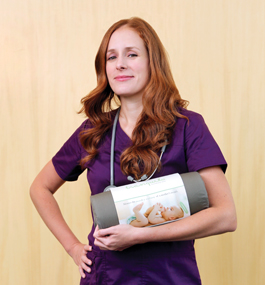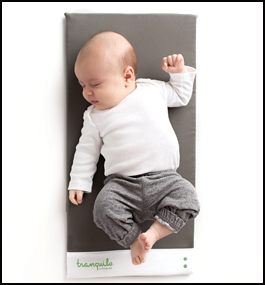The Mother of All Baby Calmers
Nurse-turned-“Shark Tank” contestant Melissa Gersin ’05 figured out how to give fretful babies and fatigued parents desperately needed R&R — stat.

Mike Lovett
Melissa Gersin ’05
by Laura Gardner, P’12
Google “How do I stop my baby from screaming?” and you get more than 21 million results in a fraction of a second.
Few problems inspire more fear and panic than an infant on a crying jag. Experts say nonstop crying afflicts up to 25 percent of newborns, and the resulting parental stress and exhaustion can lead to depression, obesity and marital friction.
Parents aren’t the only ones who instinctively dread ear-splitting wails. The sound of bawling babies is so psychologically destabilizing that the U.S. military has piped recordings of it into detainees’ cells at Guantánamo Bay.
This desperation undoubtedly accounts for a chunk of the $12,000 that parents spend, on average, on baby products during their infant’s first year, fueling a market estimated at more than $44 billion in the U.S., according to the website Statistic Brain.
“The sound of a baby crying is torture for new parents,” says maternity nurse Melissa Gersin ’05, a certified infant-crying specialist who has soothed thousands of crybabies while working at several Boston hospital nurseries.
Even a professional baby calmer like Gersin can get a little rattled. On one overnight shift six years ago at Tufts Medical Center, Gersin found herself using both hands and a foot to rock several bassinets and incubators while “shh-ing” at full volume.
“These were kids who needed constant motion and constant sound,” says Gersin.
That’s when “a lightning-bolt idea struck,” she says. “The typical soothing methods, like rocking a baby in your arms all night or taking a long car ride, are too exhausting. I began envisioning a tool for soothing babies. Something that could be stashed in a diaper bag and used anywhere babies go.” Maybe a portable vibrating mat — something that combined the constant motion babies love with soothing sounds that mimic what they used to hear in the womb.
Gersin asked fellow maternity nurses at Tufts what they thought about her idea. They were enthusiastic. But, she says, when she approached the hospital administration about developing it, “some guy in an office” turned her down.
She decided to build that mat herself.
Pleasant pandemonium
“Brandeis honed my ability to think through complex problems critically, from different angles,” says Gersin, so she knew she could come up with a design.
As a newly minted nurse, she had taken a one-day course on baby doc Harvey Karp’s “Five S’s” method of settling infants. She learned why infants sometimes cry with abandon for no good reason. “Babies miss being inside the womb,” close quarters that are always loud and always in motion, she says.
At 80-90 decibels, the noises heard in the womb are as loud as a vacuum cleaner. Between the mother’s physical movements and the soundscape of her voice, heartbeat, blood flow and other bodily functions, the womb is in a state of relentless ruckus. It’s paradoxical that parents spend countless hours and dollars trying to create calm and quiet for newborns.
Gersin began developing a prototype that could safely simulate the womb’s sounds and motions. A sociology major at Brandeis, she was, with Google’s help, a dogged researcher.
She taught herself to solder electric circuits and combine motors in tandem. For her first prototype, she soldered together a series of small vibrating Radio Shack motors and placed them inside a yoga mat. To protect the electronics from the inevitable leaks and spills of infancy, she stitched a waterproof cover, then placed a cozy cotton cover over that for baby to lie on.
For her next iteration, she pulled a computer chip and a battery pack from a vibrating pillow, and made a mat that could create multiple vibrations and had a 65-decibel white-noise component.
It was late 2012. Gersin needed a baby beta tester. Luckily, she knew a mother whose baby screamed until he turned purple every time he was strapped into his car seat — as if he were the one being tortured, not his freaked-out mom. Gersin placed her mat over the baby, and, for the first time, he grew calm in the car seat. Instantly.
“The mom wanted to drive to an ATM on the spot and pay me $100 cash for the mat,” recalls Gersin. “That’s when I knew it was something.”

page 2 of 2
Growth spurt
After testing the mat successfully on several other babies, Gersin filed a provisional patent. An early licensing deal never got off the ground, costing her months in product-development time and teaching her the importance of cutting your losses when you hit a dead end.
She urgently needed money to continue safety testing and improving the mat’s sounds and vibrations. By selling her Cambridge condo (she moved into a tiny rental house in suburban Bedford) and combining the proceeds with a small inheritance, she scraped up $198,000 — enough to keep the startup afloat. Ultimately, she was able to put five levels of vibrations and two different heartbeats into a waterproof foam mat with a washable cover.
In April 2015, after four years of gestation, the Tranquilo (pronounced tran-KEY-loh) Mat was born. Its ability to transform a baby bender into baby bliss, as shown in commercials posted on YouTube, is so fast it’s funny, giving new meaning to the phrase “good vibrations.” The babies don’t just stop crying; they actually crack a smile before dozing off.
By early 2016, following more safety improvements, the mat was ready to go into production at a factory in China. Her company started preselling the mats, primarily through its website, and by the end of the year Gersin had 2,000 orders and $85,000 in sales.
Meanwhile, in June 2016, the startup accelerator MassChallenge selected Gersin as one of its top 128 applicants, giving her networking opportunities, office space, mentorship and practice pitching the Tranquilo Mat to big-name potential investors. The nonprofit ultimately awarded Gersin $50,000 in no-equity, no-strings-attached funding, which she used to purchase inventory.
“Until MassChallenge, I was a nurse who had a business,” says Gersin. “The startup accelerator made me a business owner and businesswoman.”
The next game changer occurred last July when the ABC reality TV show “Shark Tank” emailed Gersin. The show bills itself as an opportunity for “people from all walks of life […] to chase the American dream, and potentially secure business deals that could make them millionaires.” Each episode features a panel of self-made industry “sharks” who grill budding entrepreneurs about their inventions, then decide whether to invest in them.
“When you get that email, you call them,” says Gersin.
A successful swim
She says she “blew through” the show’s 10-step application process, in which she had to prove her sales numbers and provide a lot of other background information.
Gersin made the cut. Her segment, which was filmed last September, aired in February. In the episode, she stands confidently before the panel, hand on hip, wearing purple nursing scrubs, a purple stethoscope dangling from her neck. She tells them she’s seeking $100,000 for a 10 percent stake in the Tranquilo Mat.
“We’re ready to save the sanity of parents around the globe,” she announces. “So, sharks, are you ready to invest in this incredible product?”
Questions and offers bombard her. She stays as calm as a baby after a good nap on the Tranquilo Mat.
Finally, shark Robert Herjavec says, “You said you’d do $200,000 for 15 percent, and you’d take that deal in a second.”
“In a second,” Gersin confirms.
“That’s my offer.”
“Done,” says Gersin.
Though she is still working out investment details with Herjavec, the immediate impact of the broadcast was startling. Within 24 hours of the show’s airing, the company had sold 2,000 mats (at $85 to $99 each) — about the same number sold during the entire previous year.
A week following the broadcast, the Tranquilo Mat had presold another 2,000 mats. By March 1, the startup reached almost $500,000 in sales — the figure it had hoped to reach by the end of 2017.
“We have a ton of growth potential in the U.S. market alone,” Gersin says. Now a full-time businessperson (who also still picks up the occasional nursing shift), she knows her 80-hour workweeks won’t be ending anytime soon.
Her customers, on the other hand, should be well-rested.
“I can give parents a better night’s sleep,” she says. “And that is priceless.”
